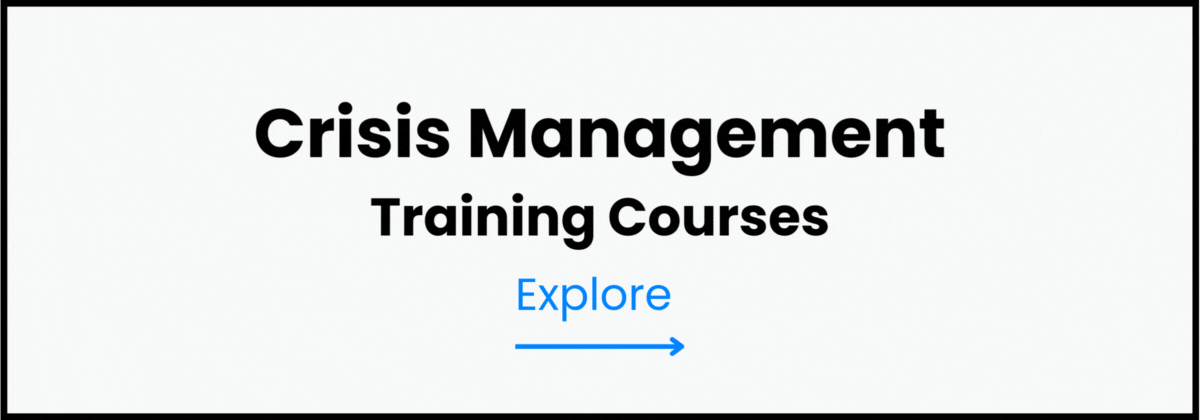How to Develop a Crisis Management Plan?
How to develop a crisis management plan is an essential skill for any organization aiming to maintain stability and resilience during unexpected disruptions. A crisis management plan is a structured framework that defines how an organization prepares for, responds to, and recovers from critical incidents that threaten its people, assets, or reputation.
Crises can take many forms, including:
- Natural disasters such as earthquakes, floods, or fires
- Cyberattacks that compromise data and operational systems
- Supply chain failures affecting production or delivery
- Public relations scandals damaging brand credibility
- Leadership issues that impact trust and organizational stability
An effective crisis management plan serves as both a preventive and reactive tool — it minimizes operational damage, protects employee safety, and preserves public confidence. By ensuring swift, coordinated action, organizations can maintain business continuity and recover faster after a disruption.
This article outlines the key stages in developing a crisis management plan — from risk identification to communication strategy and post-crisis review — helping organizations build the foresight and structure needed to navigate emergencies with confidence and control. Crisis Management Training Courses
Understanding the Purpose of a Crisis Management Plan
Every organization, regardless of size or industry, needs a crisis management plan to prepare for unforeseen disruptions and protect its people, assets, and reputation. The purpose of such a plan extends beyond procedures — it establishes a proactive framework that enables organizations to respond swiftly, make informed decisions, and maintain resilience when facing uncertainty.
A well-designed crisis management plan helps organizations:
- Protect employees and stakeholders: Ensures safety, clear communication, and coordinated actions during emergencies.
- Minimize operational and financial losses: Reduces downtime, supply chain disruption, and reputational damage through structured response protocols.
- Maintain business continuity and public trust: Keeps essential operations running while reinforcing stakeholder confidence in the organization’s stability.
It’s also important to distinguish between related concepts:
- Crisis management focuses on handling the event itself.
- Business continuity ensures critical operations persist during and after a disruption.
- Emergency response addresses immediate safety and containment actions.
Ultimately, developing a crisis management plan is not just a compliance requirement — it’s a core leadership responsibility. Proactive planning empowers organizations to act decisively, safeguard their people, and emerge stronger after a crisis. NCEMA 7000:2021 – Crisis Management and Recovery Course
Key Principles of Effective Crisis Management
An effective crisis management plan is built on a set of core principles that guide every decision, action, and communication during times of uncertainty. These principles ensure that organizations remain structured, responsive, and focused even under extreme pressure.
-
Preparedness:
Anticipate potential crises before they occur. Identify risks, develop response procedures, and train teams regularly to ensure readiness. Preparation transforms reaction into strategy.
-
Clarity:
Define a clear chain of command and decision-making hierarchy. Everyone should know their roles, responsibilities, and reporting lines to prevent confusion during high-stress situations.
-
Communication:
Establish fast, transparent, and accurate communication channels. Timely messaging — both internal and external — helps prevent misinformation, maintain trust, and ensure coordinated responses.
-
Responsiveness:
Take decisive action to contain the crisis and mitigate its effects. Rapid response minimizes operational damage and demonstrates leadership competence.
-
Accountability:
Assign clear ownership of each task and decision. Accountability ensures that responsibilities are met efficiently and that no critical issue goes unaddressed.
-
Resilience:
Learn from every incident to strengthen future preparedness. Post-crisis evaluations should identify lessons learned and inform process improvements.
These principles form the backbone of any robust crisis management framework, ensuring organizations not only survive disruptions but also emerge more agile, trusted, and resilient.
Step-by-Step Guide: How to Develop a Crisis Management Plan
Building an effective crisis management plan requires a structured, well-coordinated approach that covers prevention, response, and recovery. Each phase contributes to strengthening resilience and ensuring that the organization can manage disruptions efficiently. Follow these key steps to develop a comprehensive plan that aligns with international best practices.
Step 1 – Identify and Assess Potential Risks
Begin by conducting a risk assessment to identify the most likely crisis scenarios that could impact operations.
- Categorize risks into operational, reputational, financial, technological, and environmental groups.
- Use analytical tools like SWOT analysis, risk matrices, or scenario planning to evaluate likelihood and potential impact.
- Involve cross-departmental teams to ensure a comprehensive understanding of all vulnerabilities.
This proactive approach enables you to anticipate crises before they escalate and prioritize areas needing preventive action.
Step 2 – Establish a Crisis Management Team (CMT)
Form a dedicated Crisis Management Team responsible for decision-making and coordination during emergencies.
- Define clear roles such as Crisis Manager, Communications Lead, Operations Head, Legal Advisor, and HR Representative.
- Establish decision-making authority, escalation protocols, and backup personnel for each role.
- Ensure team members undergo specialized training in crisis management procedures and communication.
A well-prepared CMT ensures rapid, unified action under pressure.
Step 3 – Define Crisis Response Protocols
Develop specific response procedures for each identified crisis type.
- Create detailed checklists and action steps tailored to scenarios such as cyberattacks, product recalls, or facility incidents.
- Outline response timelines — what must be done in the first 30 minutes, first hour, and within 24 hours.
- Include practical measures like evacuation routes, IT system shutdown processes, or media response steps.
Documenting these protocols ensures clarity and efficiency when time is critical.
Step 4 – Develop a Crisis Communication Strategy
Communication can make or break an organization’s reputation during a crisis. A structured communication strategy ensures consistency, speed, and transparency.
- Prepare internal and external communication templates for different crisis scenarios.
- Identify official spokespersons and create an approval chain for all outgoing messages.
- Use pre-approved, secure communication channels such as email, intranet, social media, and press releases.
- Align the strategy with ISO 22361:2022 — Crisis Management Guidelines, emphasizing clarity and credibility.
Proactive and honest communication helps maintain stakeholder confidence and control the narrative during challenging times.
Step 5 – Create Business Continuity and Recovery Plans
Crisis management doesn’t end with containment — it extends into recovery and restoration.
- Outline how critical operations will continue during disruption.
- Identify backup systems, alternate suppliers, and remote work arrangements to minimize downtime.
- Define measurable recovery metrics such as RTO (Recovery Time Objective) and RPO (Recovery Point Objective) to track progress.
A strong business continuity framework ensures resilience and accelerates the return to normal operations.
Step 6 – Train, Test, and Update the Plan
A plan is only effective when tested regularly.
- Conduct simulation exercises or tabletop drills to evaluate preparedness and response efficiency.
- Gather feedback from participants and identify gaps or improvement areas.
- Establish a continuous improvement cycle, reviewing and updating the plan quarterly or after each incident.
Consistent training fosters a culture of readiness across the organization.
Step 7 – Post-Crisis Review and Learning
After the crisis has been managed, conduct a thorough post-crisis evaluation to strengthen future response.
- Document outcomes, lessons learned, and best practices for future reference.
- Hold a debrief session with all stakeholders to discuss what worked and what didn’t.
- Update the crisis management manual, training content, and risk registers accordingly.
By learning from every event, organizations build long-term resilience and ensure that each crisis strengthens rather than weakens their operations.
Crisis Communication: Managing the Narrative
In any crisis, communication determines perception. How an organization manages information flow, tone, and transparency directly shapes public trust and stakeholder confidence. The goal of effective crisis communication is not only to inform but also to reassure — demonstrating leadership, accountability, and empathy in the face of uncertainty.
Key actions for managing the narrative include:
- Communicate quickly and factually:
Speed matters. Address the situation as soon as possible with verified information. Silence or delayed responses can fuel speculation and misinformation. - Acknowledge uncertainty but show control:
It’s acceptable to admit when all details are not yet known — what matters is demonstrating that the situation is being managed responsibly and decisively. - Use consistent messaging across all channels:
Ensure that statements shared through email, social media, press releases, and internal communications are aligned. Inconsistencies erode credibility and create confusion. - Train spokespersons for media and stakeholder interactions:
Designate and prepare official representatives to handle public inquiries. They should be calm, informed, and able to communicate clearly under pressure. - Emphasize empathy in tone:
Words carry emotional weight. Communicate with compassion and concern, especially when people or communities are affected. A human-centered message reduces reputational harm and strengthens trust during recovery.
Ultimately, crisis communication is about balancing transparency with authority. When organizations communicate swiftly, honestly, and empathetically, they not only contain the crisis but also emerge with their integrity — and reputation — intact. Disaster Recovery & Business Continuity Training Course
Common Mistakes to Avoid When Developing a Crisis Management Plan
Even the most well-intentioned organizations can undermine their crisis preparedness by overlooking critical details. When learning how to develop a crisis management plan, it’s just as important to understand what not to do. Avoiding these common pitfalls ensures your plan remains practical, adaptable, and effective under real-world pressure.
-
Treating the plan as a static document
A crisis management plan should evolve with the organization. Failing to review and update it regularly renders it obsolete when new risks emerge. Schedule periodic reviews — at least annually or after every major incident — to ensure accuracy and relevance.
-
Failing to assign clear accountability
Without defined roles and responsibilities, confusion can delay response times. Establish a clear chain of command, assign ownership for each action step, and ensure backups are in place for key roles.
-
Overlooking internal communication needs
Many organizations focus on public statements but neglect employee communication. During a crisis, internal alignment is critical — staff should know exactly what’s happening, what actions to take, and how to communicate with customers or partners.
-
Not involving external stakeholders or partners
Crises rarely occur in isolation. Vendors, regulators, emergency services, and media contacts should all be included in planning discussions and simulations. Their collaboration can significantly improve coordination during a real event.
-
Ignoring post-crisis learning
Once the crisis passes, many teams move on without reflection. Skipping this step leads to repeated mistakes. Conduct a post-crisis review to document lessons learned, evaluate response effectiveness, and update procedures accordingly.
By avoiding these mistakes, organizations strengthen their crisis management maturity — ensuring that the plan remains a living, actionable strategy capable of protecting both people and reputation when it matters most. Strategic Crisis Management for Emergency Situations Course
FAQs
-
What is a crisis management plan, and why is it important?
A crisis management plan is a structured framework that outlines how an organization prepares for, responds to, and recovers from unexpected disruptions. It’s vital because it helps protect employees and assets, maintain operations, and preserve trust with stakeholders during emergencies.
-
What are the key steps to developing a crisis management plan?
The key steps include identifying potential risks, establishing a Crisis Management Team (CMT), defining response protocols, creating a communication strategy, developing business continuity plans, and conducting regular training and reviews.
-
Who should be part of the crisis management team?
A well-structured CMT typically includes a Crisis Manager, Communications Lead, Operations Head, Legal Advisor, and HR Representative. Each member plays a defined role in ensuring fast decision-making and coordinated actions during crises.
-
How often should a crisis management plan be updated or tested?
A crisis management plan should be reviewed and tested at least once a year — or after every major incident. Regular simulations and tabletop drills help identify weaknesses and keep teams prepared for evolving threats.
-
What is the difference between crisis management and business continuity?
Crisis management focuses on handling the event itself, including response and communication. Business continuity, on the other hand, ensures that critical operations continue during and after the disruption, minimizing long-term impact.
-
How do you communicate effectively during a crisis?
Effective crisis communication involves speed, accuracy, and empathy. Share verified information quickly, maintain consistent messaging across all platforms, acknowledge uncertainty honestly, and demonstrate control and compassion in tone.
-
What tools can help organizations manage crises more efficiently?
Tools such as risk management software, emergency notification systems, cloud-based communication platforms, and incident tracking dashboards help coordinate responses, share real-time information, and monitor recovery progress.
-
How can leadership training improve crisis preparedness?
Leadership training courses build decision-making, emotional intelligence, and communication skills — all crucial for managing crises. Trained leaders can act calmly under pressure, make informed choices, and guide teams confidently through uncertainty.
Explore Courses From Our Top Categories:
➡️Business Training Courses – ➡️ Data Training Courses – ➡️ Technical Training Courses – ➡️ HSSE Training Courses





